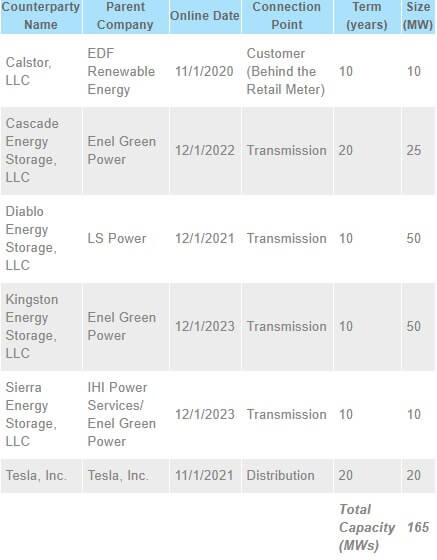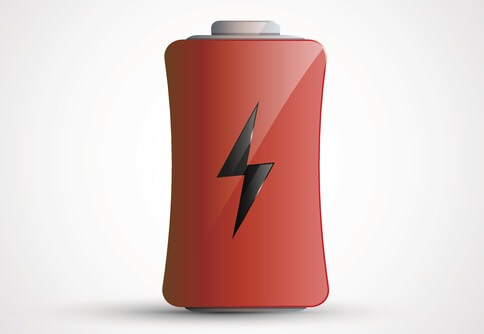Pacific Gas and Electric Co. (PG&E) says it has strengthened its commitment to a clean energy future after submitting six new energy storage contracts totaling 165 MW to the California Public Utilities Commission (CPUC) for review and approval.
California’s Energy Storage Decision requires investor-owned utilities in the state to procure 1,325 MW of storage by 2020. PG&E’s share is 580 MW. Since 2015, PG&E has signed contracts for 79 MW of new energy storage capability.
According to the utility, storage plays an increasingly important role for California energy companies as they work to achieve the state’s ambitious clean energy goals. By the end of 2017, PG&E forecasts that about 33% of its retail electric deliveries will come from renewable sources. Energy storage will help integrate many of those resources, such as wind and solar, which are intermittent or provide peak output during times of low demand.
On Dec. 1, 2016, PG&E issued a request for offers to solicit proposals for energy storage projects. The projects were required to be between 1 MW and 50 MW and needed to be operational no later than the end of 2024.
In addition to third-party-owned storage offers, PG&E identified a distribution substation where it would like to consider energy storage projects on distribution circuits to defer distribution investments. PG&E also identified three sites where it owns and operates solar photovoltaic facilities where energy storage could be added.
Martin Wyspianski, PG&E’s senior director for energy portfolio procurement and policy, says he was pleased with the progress PG&E has made toward meeting California’s renewable energy and storage goals.
“As our clean energy portfolio grows, so does the importance of storage technology. These contracts and the storage capacity they represent will help us better integrate our growing renewable generation sources and bring increased reliability to the grid. They are an important milestone in our progress toward a clean energy future,” says Wyspianski.
Over the last 12 months, PG&E staff reviewed applications from numerous vendors interested in participating in the storage market. The six new projects selected are for lithium-ion battery technology. Pending CPUC approval, the first projects are due to come online in November 2020.
Enel Green Power North America, a U.S. subsidiary of Enel S.p.A., was a major contract winner, having signed three capacity storage agreements with PG&E for a total capacity of 85 MW/340 MWh. Under the agreements, Enel will build the Kingston, Cascade, and Sierra stand-alone lithium-ion energy storage projects, which will all be located in California.
“The signing of these agreements marks an important step forward in our group’s plan to strengthen its presence in the energy storage market and expand this business in the U.S., and California in particular, which are at the forefront in the development of this market,” says Enrico Viale, head of Enel Global Thermal Generation.
The three facilities, all located across central and northern California, are the 50 MW/200 MWh Kingston project, the 25 MW/100 MWh Cascade project and the 10 MW/40 MWh Sierra project. The projects are developed with Sovereign Energy Storage, an independent developer of large-scale utility battery energy storage projects, and are expected to be operational by 2023.
Meanwhile, EDF Renewable Energy (EDF RE) was the utility’s sole awardee for behind-the-meter (BTM) storage, having signed a 10 MW/40 MWh energy storage contract. Under the deal, EDF RE will build, own and operate a portfolio of BTM battery storage projects for commercial and industrial customers within the PG&E service territory.
EDF RE says the contract will enable the company to assist selected PG&E customers to lower their utility bills by reducing demand charges, maximizing consumption during off-peak hours, and collecting revenue from wholesale market participation. According to the company, each project will optimize the host customer’s energy usage and operating costs by utilizing EDF’s proprietary PEGASE Energy Management System (EMS) to strategically operate the batteries.
Raphael Declercq, vice president of portfolio strategy at EDF RE, comments, “We are thrilled to be the sole awardee in the behind-the-meter category. This contract will enable EDF RE to demonstrate its capabilities in the California storage market. The depth of resources and experience within the EDF Group positions us well to meet our customer’s expectations. Worldwide, EDF has installed 824 MWh of battery storage; this experience will benefit both PG&E and the host customers we have started to sign up.”
PG&E says energy storage has been a part of the utility’s power mix for decades, starting with the Helm’s Hydro-electric Facility and continuing with pilot projects such as the 2 MW Battery Storage Pilot at the Vacaville Substation and the 4 MW Yerba Buena Battery Energy Storage System located on the property of Silicon Valley storage technology company HGST.
A full list of the new contract awardees is available in the chart below, courtesy of PG&E.





